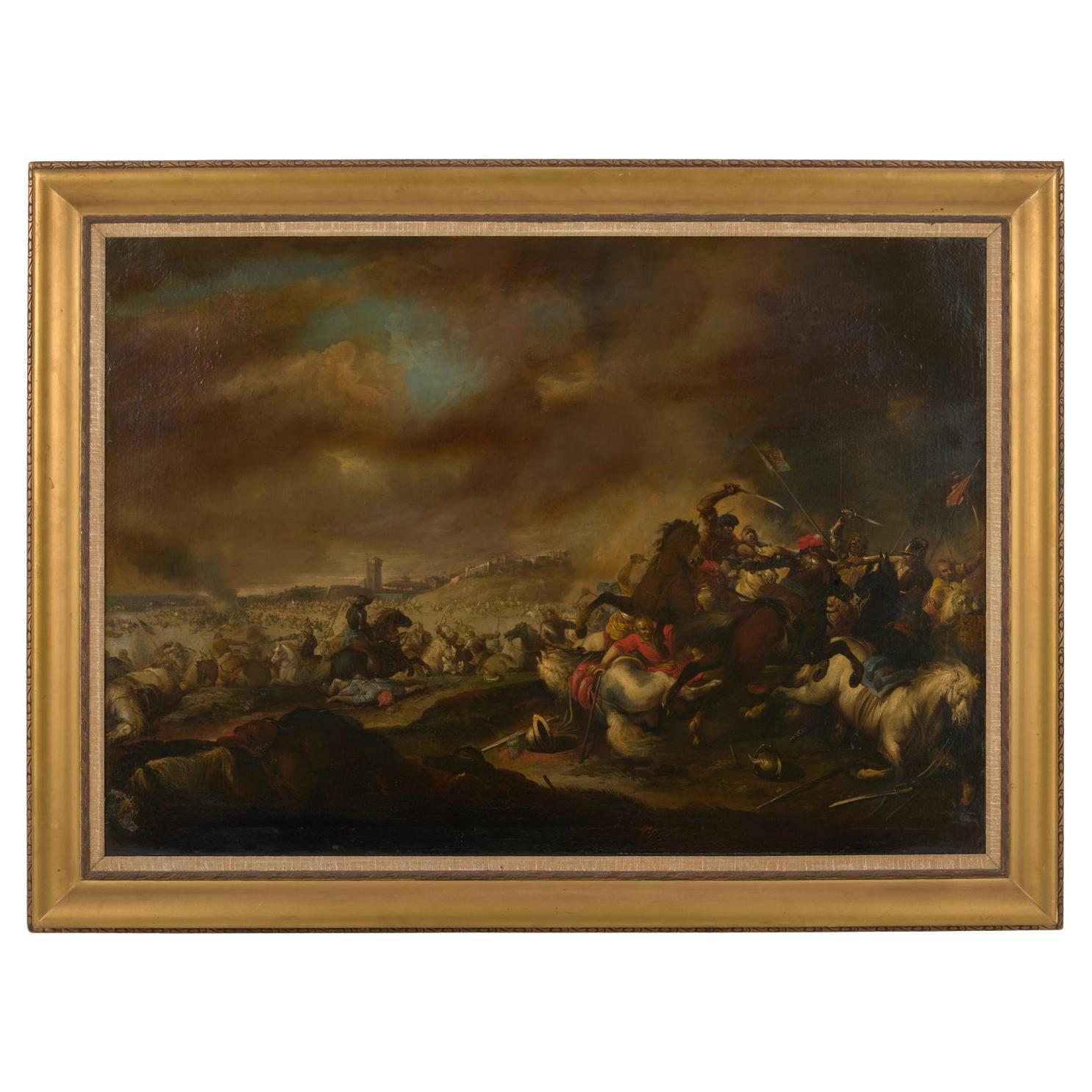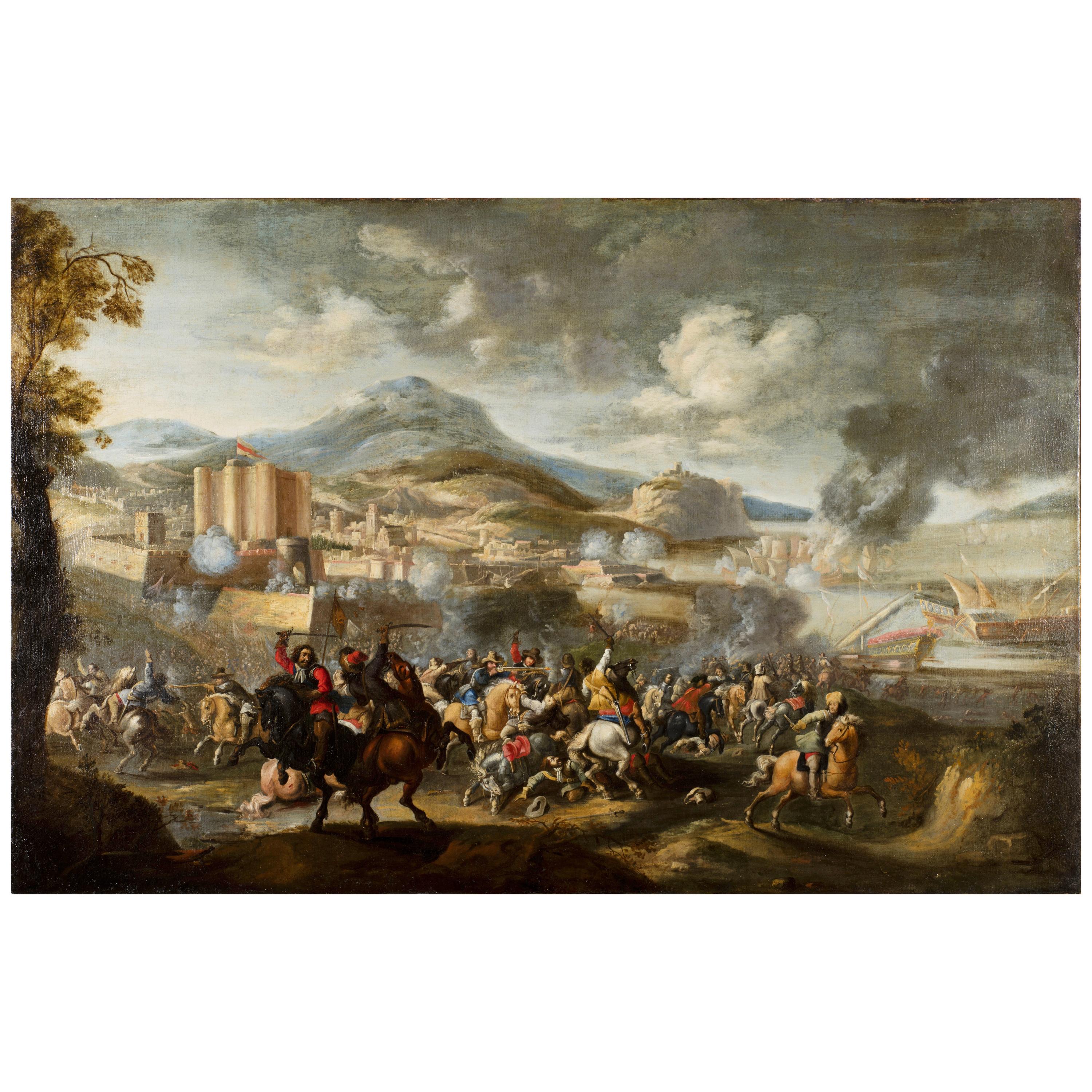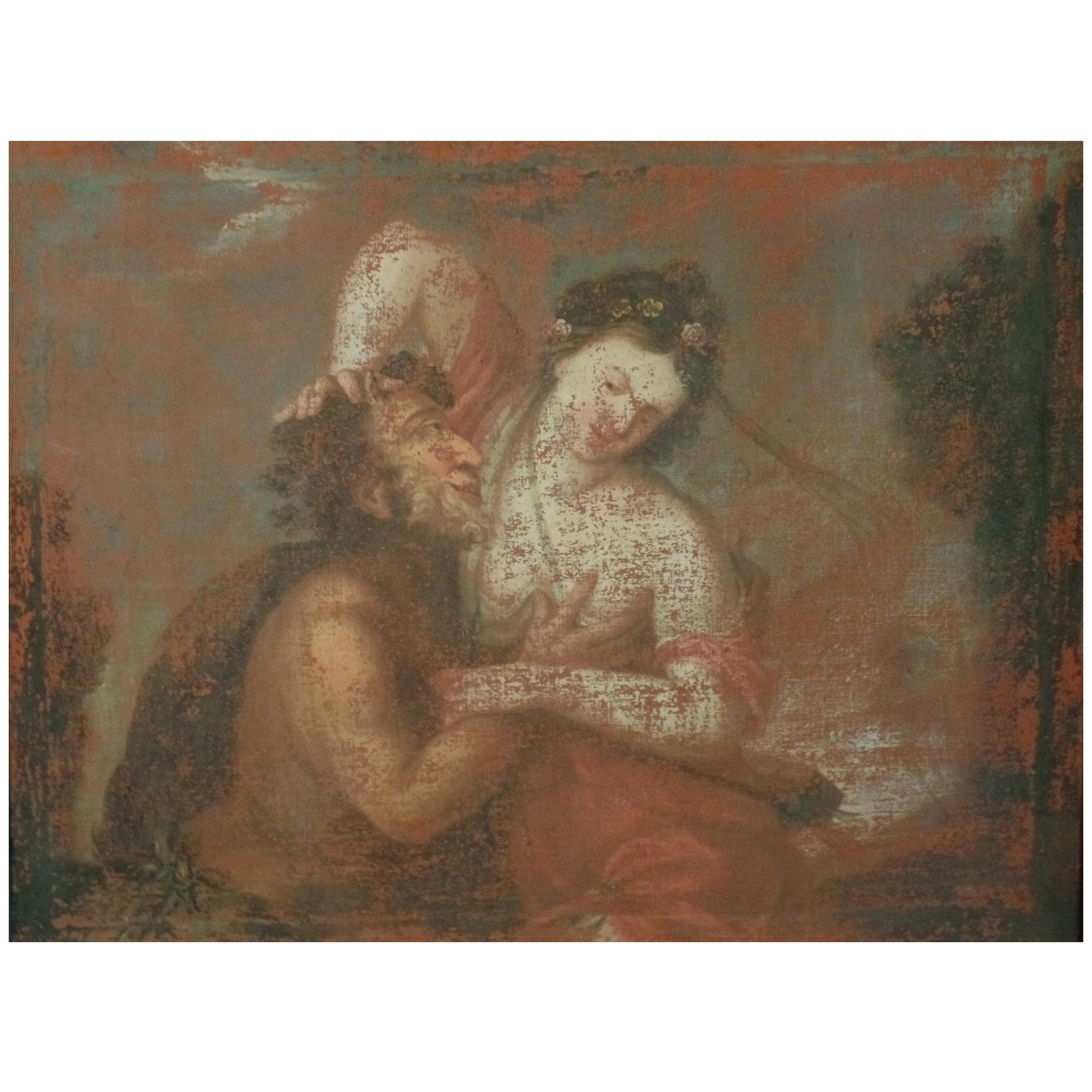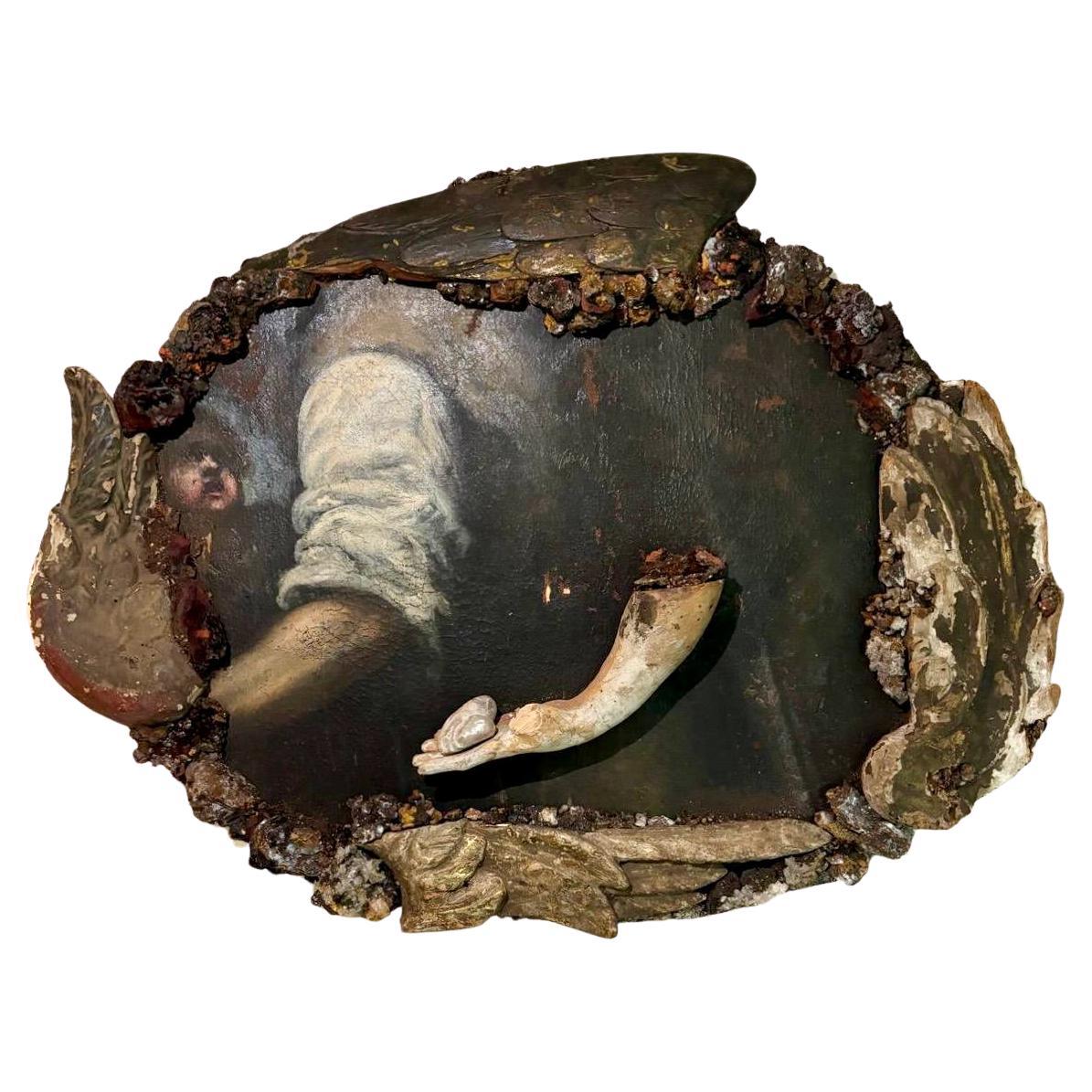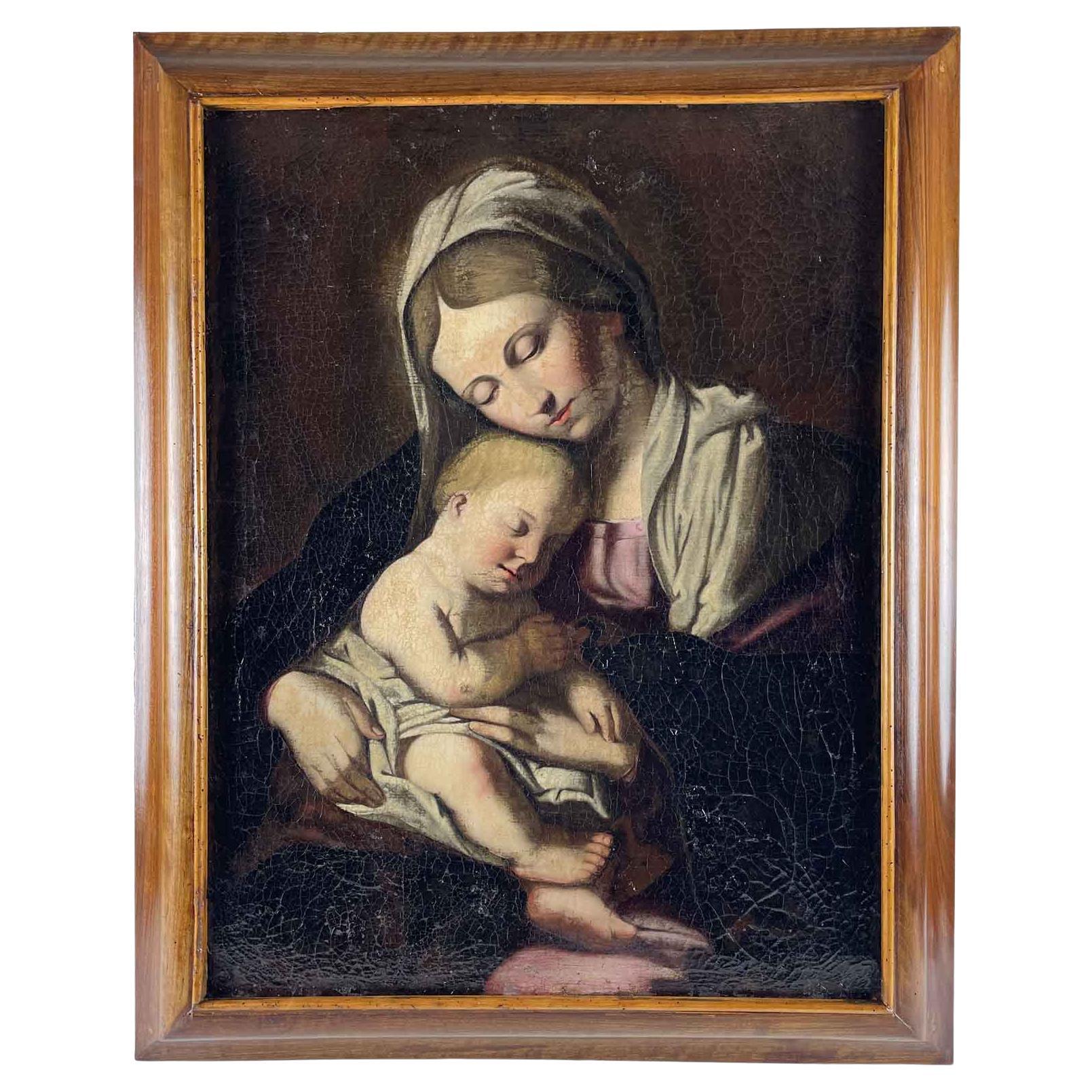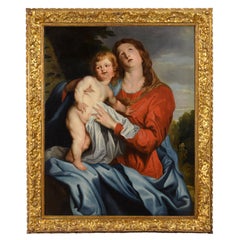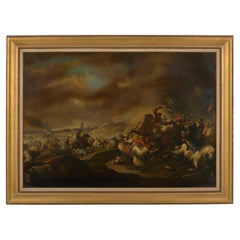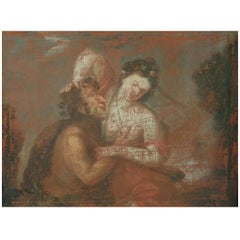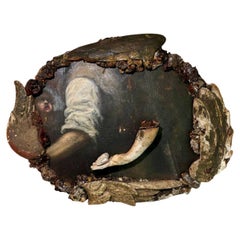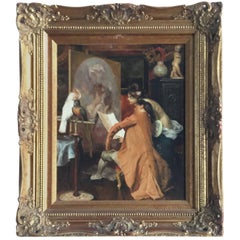Items Similar to 17th Century, Italian Painting with Battle Between Christian and Turkish Cavalry
Want more images or videos?
Request additional images or videos from the seller
1 of 15
17th Century, Italian Painting with Battle Between Christian and Turkish Cavalry
About the Item
17th century, Italian oil on canvas painting with battle between Christian and Turkish cavalry
The oil on canvas painting depicts a battle between Christian and Turkish cavalry. Characterized by a strong dynamism, the main scene occupies the lower horizontal section of the canvas. In the background is the continuation of the clash just outside the walls of a city whose towers delimit the horizon. On the left some hills fade on the horizon. The sky is marked by clouds of serene contrast with the black smoke of the battle.
Stylistically the painting can be traced back to a painter active in Italy in the seventeenth century, continuator of the major interpreter of the genre, Jacques Courtois called Il Borgognone (Saint-Hyppolite 1621 - Rome 1676). The genre of battle painting met with great success in the collections of the Italian and European nobility of the 17th and 18th centuries and there are many painters who ventured in this thematic genre.
The battles of the Italian Renaissance, in which the scene converged towards a precise protagonist, evolved in the seventeenth century towards a type of combat "without hero". The bloody realism of the details and the dynamic development of the narrative confuse the figure of the protagonist, when present, to give importance to the swirl of horses and armed fighters, among which, moreover, does not emerge a winner.
It is currently the drafting of expertise of the work useful to identify the hand of the painter through historical artistic studies; in addition, new images will soon be inserted.
- Dimensions:Height: 30.32 in (77 cm)Width: 57.09 in (145 cm)Depth: 1.97 in (5 cm)
- Style:Baroque (Of the Period)
- Materials and Techniques:
- Place of Origin:
- Period:Mid-17th Century
- Date of Manufacture:Mid-17th Century
- Condition:
- Seller Location:IT
- Reference Number:1stDibs: LU4405221205492
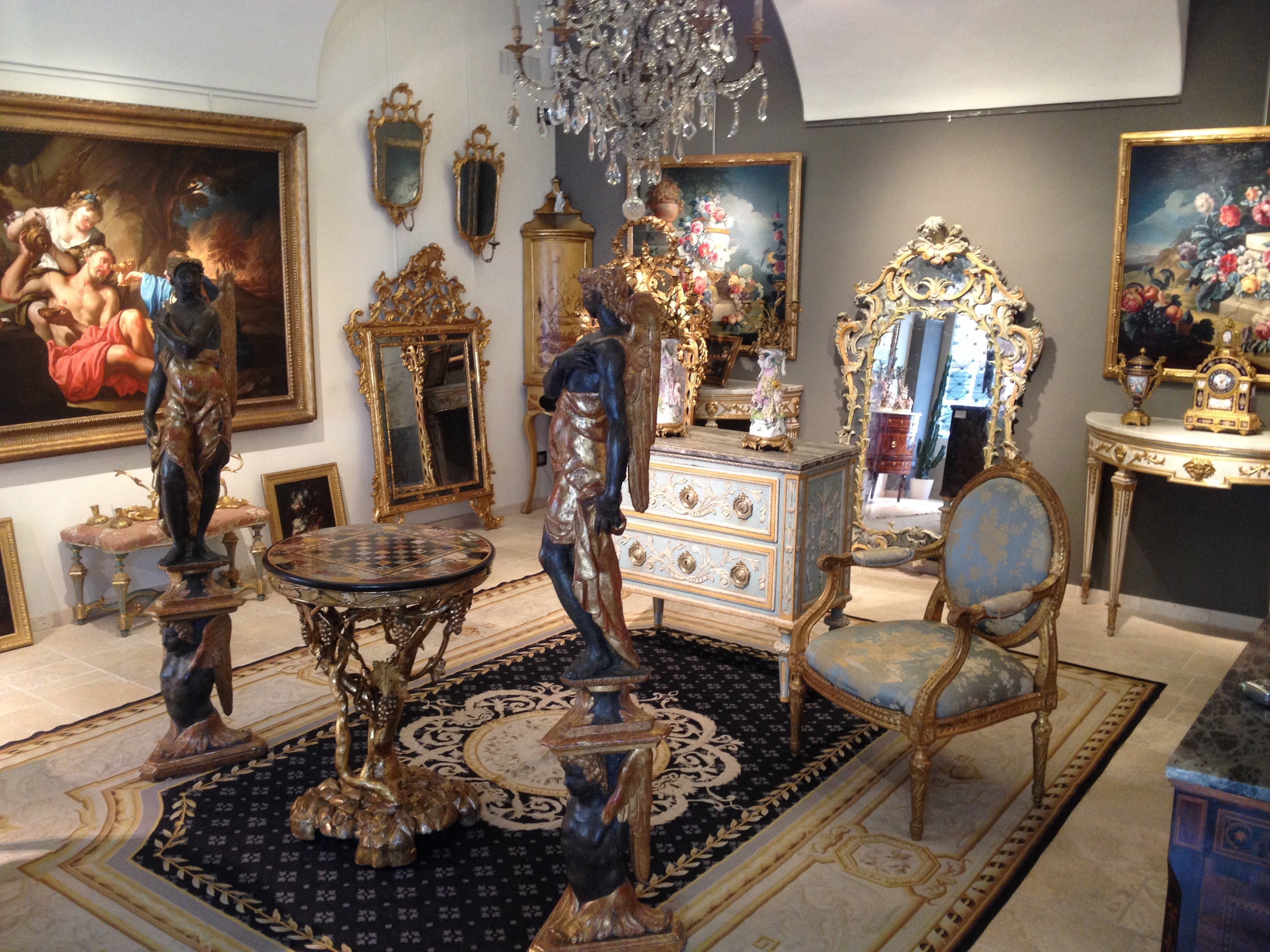
About the Seller
5.0
Platinum Seller
Premium sellers with a 4.7+ rating and 24-hour response times
Established in 1980
1stDibs seller since 2019
53 sales on 1stDibs
Typical response time: <1 hour
- ShippingRetrieving quote...Shipping from: Italy
- Return Policy
Authenticity Guarantee
In the unlikely event there’s an issue with an item’s authenticity, contact us within 1 year for a full refund. DetailsMoney-Back Guarantee
If your item is not as described, is damaged in transit, or does not arrive, contact us within 7 days for a full refund. Details24-Hour Cancellation
You have a 24-hour grace period in which to reconsider your purchase, with no questions asked.Vetted Professional Sellers
Our world-class sellers must adhere to strict standards for service and quality, maintaining the integrity of our listings.Price-Match Guarantee
If you find that a seller listed the same item for a lower price elsewhere, we’ll match it.Trusted Global Delivery
Our best-in-class carrier network provides specialized shipping options worldwide, including custom delivery.More From This Seller
View All17th Century, Italian Painting with Battle attributed to Marzio Masturzo
Located in IT
Marzio Masturzo, attributed (Active in Italy - in Naples and Rome- in the second half of the 17th century)
"Battle between cavalry and vessels with fortified city on the left"
...
Category
Antique Late 17th Century Italian Baroque Paintings
Materials
Canvas
$39,177 Sale Price
25% Off
17th Century, Italian Painting with Still Life with Fruit, Dogs and Cat
Located in IT
17th Century, Italian painting with still life with fruit, dogs and cat
Measurements: With frame cm W 93 x H 75.5 x D 4; Frame cm W 82.5 x H 66.5
The...
Category
Antique 17th Century Italian Baroque Paintings
Materials
Canvas
$17,179 Sale Price
20% Off
17th Century, Italian Painting with Saint Cecilia with Angels in Concert
Located in IT
17th century Roman school, Santa Cecilia with angels in concert, oil painting on canvas
The valuable painting, in excellent condition, depicts Sa...
Category
Antique 17th Century Italian Baroque Paintings
Materials
Canvas
$29,716 Sale Price
20% Off
17th Century, Italian Painting with Virgin and Child by Follower of Van Dyck
By Anthony van Dyck
Located in IT
17th century, Italian painting with virgin and childr by Follower of Sir Anthony van Dyck
cm W 90 x H 113; cornice cm W 111 x H 135 x D 7
The canvas depicts the Madonna with the Chi...
Category
Antique Late 17th Century Italian Baroque Paintings
Materials
Canvas
$32,502 Sale Price
20% Off
17th Century, Italian Painting by Pier Francesco Cittadini, Jacob and his Family
Located in IT
Pier Francesco Cittadini (Milan, 1616-Bologna, 1681)
"Jacob and his family go to Egypt"
Oil on canvas, cm 109 x 190 (canvas only)
The valuable painting, made in oil on canvas, depicts Jacob and his family go to Egypt and we believe it can be, given the high quality painting, autograph work of Italian Pier Francesco Cittadini (Italy Milan, 1616 - Bologna, 1681) made after 1647. The work, in excellent condition is accompanied by a coeval frame in wood finely carved and golden.
The scene depicted, which was confused with the Flight to Egypt in the past years, is instead identified with the biblical episode of Jacob’s journey. In the foreground, reading the painting from left to right, we see a caravan composed of animals, including donkeys, dromedaries, goats, dogs and horses and people, women, men and slaves, who carry on their journey along the banks of a river, following a path that to the right, would seem to lead to the through of a bridge. In addition to the watercourse is described an environment characterized by large rocks and impervious come far to cover the entire verticality of the canvas. On the left, in the distance, we see the tail of the caravan that runs along the steep path. Large trees enliven and harmonize the environment, as well as white and grey clouds characterize the predominantly clear sky and illuminated on the right by sunlight.
The story is told in the Bible, Book of Genesis, 30, 25, passage in which is described the flight of Jacob from Haran after the contrasts with Laban, father of his wife Rachel. Jacob is the third great patriarch of the Bible. From his descendants originate the twelve generations of the people of Israel. He is the son of Isaac and Rebekah, who led him to flee from the wrath of Esau to Haran to seek refuge from his brother, Laban. At his uncle’s house Jacob met his daughter Rachel. As soon as he saw his cousin, Jacob was taken. Jacob will stay seven years in the service of Laban to marry his beloved Rachel. But Laban, with a deception, will give him in marriage first Lia, the least beautiful eldest daughter, and only after another seven years the splendid Rachel. From his first wife he will have several children, while Rachel will give birth to the beloved son, Joseph, who will become viceroy of Egypt.
After years of service, Jacob asked to be paid with every dark-coloured garment among the sheep and every spotted and dotted garment among the goats. Laban accepted and sent away from his sons all the leaders of that kind. So Jacob took fresh branches of poplar, almond and plane tree, and flayed them, and put them in the troughs. The optical suggestion induced the goats and the sheep to conceive and give birth to dark, striped and dotted garments. He also ensured that all the strongest and healthiest leaders of the flock of Laban would drink near the barked branches, thus assuring a genetic superiority to his part of the flock. His flocks grew numerous and strong and he became richer than his relative, arousing envy. It was clear that Laban would not respect him much longer. At the suggestion of the Lord, Jacob decided to return to Canaan. Trying to avoid any possible dispute, he left with his family while Laban was absent for shearing sheep. But when, three days later, his uncle returned home, he became angry, feeling offended because Jacob had gone secretly and had not allowed him to greet his daughters and grandchildren. In addition, his teraphim, statuettes, or idols, which depicted the family deities, had disappeared. After 7 days of pursuit, Laban and his men reached Jacob’s group on Mount Gilead, in the mountainous region west of the Euphrates River, where his uncle and grandson had a stormy conversation. The younger man was outraged at being accused of stealing idols and told Labano to rummage through his family’s tents at will. Neither of them could know or even imagine that it was Rachel who took the idols and hid them in the saddle of the camel. During the search, she sat down firmly on the saddle, apologizing for not being able to get up, «because I usually have what happens to women» (Gen 31:35). So the loot wasn’t discovered.
The author of this work was inspired by the composition of an engraving by Stefano Della Bella (1610-1664) of circa 1647. The engraving by Stefano della Bella bears the title "Iacob sur ses vieux jours quitte sans fascherie pour voir son filz Ioseph, sa terre et sa patrie" and is signed on the bottom left "Stef. of the Beautiful In. et fe." while on the right it is declared "Cum privil. Regis", that is with license of the king.
Stefano Della Bella (Italy - Florence, May 18, 1610-Florence, July 12, 1664) was born in a family of painters, sculptors and goldsmiths and was left early orphan of his father sculptor, he dedicated himself first to the art of goldsmith at the school of Giovanni Benedetto Castiglione and Gasparo Mola, then turning his attention to drawing and engraving. He soon began drawing figures and copying the etchings of Jacques Callot, which inspired his early works. Under the protection of the Medici, in particular of Don Lorenzo, cadet son of Grand Duke Ferdinand I, Della Bella has the opportunity to make study trips to Rome, where he stayed from 1633-1636; In Rome he met French engravers and publishers of prints such as Israël Henriet and François Langlois, who influenced his decision to move to Paris in 1639, four years after the death of Callot. In Paris he soon reached, thanks to the engravings commissioned by Cardinal Richelieu, the success also worldly; he frequented courtiers, theatre artists and writers, while refusing too oppressive honors. In 1646-1647 he continued his travels in the Netherlands to Amsterdam, Antwerp and Dordrecht. He returned to Florence in 1650 and resumed working under the protection of the Medici court, working for his patrons. In 1656 he became a member of the Academy of Apatists.
The painting object of this study is reasonably attributable to Pier Francesco Cittadini, or Pierfrancesco Cittadini, called the Milanese or the Franceschino (Italy - Milan, 1616-Bologna, 1681) as some exemplary stylistic comparisons proposed to follow can prove.
Pier Francesco Cittadini was an Italian baroque painter, mainly active in Bologna.
His artistic training first took place with the painter Daniele Crespi...
Category
Antique Mid-17th Century European Baroque Paintings
Materials
Canvas, Giltwood
$35,288 Sale Price
32% Off
17th Century, Pair Italian Paintings Architectural Capriccio by Alberto Carlieri
By Alberto Carlieri
Located in IT
17th century, Pair of paintings depicting Architectural Caprices with Bacchanal and Sacrifice Scene, Alberto Carlieri (Rome 1672-1720)
Oil on canvas; Dimensions: canvas cm H 73.5 x W...
Category
Antique Late 17th Century Italian Baroque Paintings
Materials
Canvas
$74,001 Sale Price
25% Off
You May Also Like
A Late 17th Century Painting Depicting A Cavalry Battle
Located in ARMADALE, VIC
A Late 17th Century Painting Depicting A Cavalry Battle
Height: 115 cm Width: 75 cm Depth: 6 cm.
Provenance: Private Australian Collection.
Category
Antique Late 17th Century Italian Baroque Paintings
Materials
Canvas
17th Century European Painting, Struggle between Satyr, Pan and a Woman
Located in New York, NY
Oil on canvas, mythological painting of Satyr (pan depicted with goat horns) and woman portraying the Classic eternal theme of Eros and the struggle against it.
European (Italian ...
Category
Antique 17th Century European Baroque Paintings
Materials
Paint, Canvas
17th Century Italian Painting with Angel Wing Frame and 17th Century Arm
By Interi
Located in Dublin, Dalkey
Titled "Vulnerabilita" by Jean O'Reilly Barlow
A 17th century Italian painting with a hand-carved 17th century arm. It is framed with 17...
Category
Antique 17th Century Italian Rococo Paintings
Materials
Quartz, Rock Crystal, Iron
17th Century Painting
Located in Miami, FL
17th century painting
J.Castano
17th century
Spain
Category
Antique 17th Century Baroque Paintings
Materials
Canvas
$25,000
Madonna With Child Italian Painting Late 17th Century
Located in Milano, MI
Madonna and Child late 1600s, oil painting on canvas from northern Italy, in good condition, within walnut frame, from a private collection in Milan. The work depicts the Virgin hol...
Category
Antique Late 17th Century Italian Baroque Paintings
Materials
Canvas, Nutwood
Neapolitan school, 17th century, battle scenes
Located in Milan, IT
Neapolitan School of the 17th Century
Battle scenes between Christians and Turks
(2) Oil on canvas, 52 x 71 cm
Framed, 61 x 80 cm
One genre that met with wide acclaim in seventeenth-century Neapolitan painting and flattering success among collectors was that of battle. The Parthenopean nobility loved to adorn the walls of their salons with battles depicting single acts of heroism or complex combats that exalted patriotism and warlike prowess, virtues with which members of the wealthy aristocracy of the time liked to identify.
The Church, in the Neapolitan area, was also at the forefront of commissions, commissioning artists to depict the spectacular triumphs of Christendom over the infidels, such as the memorable naval battle of Lepanto in 1571, which marked a historical turning point with the great victory over the Turks, becoming a repeated iconographic motif imbued with devotional value, replicated several times through the interest of the Dominican order, which was very devoted to Our Lady of the Rosary, who benevolently followed earthly events from above in heaven. Other themes dear to the Church within the genre were drawn from the Old and New Testaments, such as Constantine's Victory at the Milvian Bridge or St. James at the Battle of Clodius.
Among the leading Neapolitan artists of that period, several specialized in battle scenes: these include Francesco Graziani, known as Ciccio Napoletano, a battler active between Naples and Rome in the second half of the 17th century; Andrea De Lione, who lived in Naples from 1610 to 1685, a versatile narrator of battles without heroes, of horsemen assaulting or retreating, and of profane scenes immersed in a wild and primordial, yet already classicized, nature; and Carlo Coppola. The latter was active for more than twenty years, from 1640 to 1665, and his catalog, which is interesting because it bears witness to a particular historical moment and the tastes of private patrons, has yet to be defined, although many of his works are initialed. It is precisely to Coppola's corpus that these two paintings could come close: with the production of the Neapolitan battler the two paintings seem to share the smoky colors, the accentuated chiaroscuro and the marked dynamism of the scenes. Moreover, it is necessary to mention how that of the battle between Christians and Turks was an absolutely central theme in Coppola's pictorial production. Also close to the manner of the two paintings analyzed here is the production of one of Coppola's most celebrated pupils, Giovanni Luigi Rocco...
Category
Antique 17th Century Italian Other Paintings
Materials
Canvas
$9,054 / set
